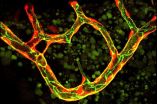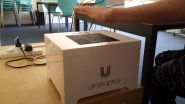(Press-News.org) As two galaxies enter the final stages of merging, scientists have theorized that the galaxies' supermassive black holes will form a "binary," or two black holes in such close orbit they are gravitationally bound to one another. In a new study, astronomers at the University of Maryland present direct evidence of a pulsing quasar, which may substantiate the existence of black hole binaries.
"We believe we have observed two supermassive black holes in closer proximity than ever before," said Suvi Gezari, assistant professor of astronomy at the University of Maryland and a co-author of the study. "This pair of black holes may be so close together that they are emitting gravitational waves, which were predicted by Einstein's theory of general relativity."
The study was published online April 14, 2015, in the Astrophysical Journal Letters. The discovery could shed light on how often black holes get close enough to form a gravitationally bound binary and eventually merge together.
Black holes typically gobble up matter, which accelerates and heats up, emitting electromagnetic energy and creating some of the most luminous beacons in the sky called quasars. When two black holes orbit as a binary, they absorb matter cyclically, leading theorists to predict that the binary's quasar would respond by periodically brightening and dimming.
The researchers conducted a systematic search for so-called variable quasars using the Panoramic Survey Telescope and Rapid Response System (Pan-STARRS1) Medium Deep Survey. This Haleakala, Hawaii-based telescope imaged the same patch of sky once every three days and collected hundreds of data points for each object over four years.
In that data, the astronomers found quasar PSO J334.2028+01.4075, which has a very large black hole of almost 10 billion solar masses and emits a periodic optical signal that repeats every 542 days. The quasar's signal was unusual because the light curves of most quasars are arrhythmic. To verify their finding, the research team performed rigorous calculations and simulations and examined additional data, including photometric data from the Catalina Real-Time Transient Survey and spectroscopic data from the FIRST Bright Quasar Survey.
"The discovery of a compact binary candidate supermassive black hole system like PSO J334.2028+01.4075, which appears to be at such close orbital separation, adds to our limited knowledge of the end stages of the merger between supermassive black holes," said UMD astronomy graduate student Tingting Liu, the paper's first author.
The researchers plan to continue searching for new variable quasars. Beginning in 2023, their search could be aided by the Large Synoptic Survey Telescope, which is expected to survey a much larger area and could potentially pinpoint the locations of thousands of these merging supermassive black holes in the night sky.
"These telescopes allow us to watch a movie of how these systems evolve," said Liu. "What's really cool is that we may be able to watch the orbital separation of these supermassive black holes get smaller and smaller until they merge."
INFORMATION:
In addition to Gezari and Liu, study authors included UMD astronomy research associate Sebastien Heinis and University of Hawaii astronomer Eugene Magnier, both of whom contributed to the photometry data used in the study.
This research was supported by the Pan-STARRS1 Science Consortium (of which UMD is a member institution), NASA (Award No. NNX08AR22G) and National Science Foundation (Award No. AST-1238877). The content of this article does not necessarily reflect the views of these organizations.
The research paper, "A Periodically Varying Luminous Quasar at z = 2 from the Pan-STARRS1 Medium Deep Survey: A Candidate Supermassive Black Hole Binary in the Gravitational Wave-driven Regime," Tingting Liu, Suvi Gezari, Sebastien Heinis, Eugene A. Magnier, William S. Burgett, Kenneth Chambers, Heather Flewelling, Mark Huber, Klaus W. Hodapp, Nicholas Kaiser, Rolf-Peter Kudritzki, John L. Tonry, Richard J. Wainscoat, and Christopher Waters, was published online April 14, 2015, in the Astrophysical Journal Letters, http://dx.doi.org/10.1088/2041-8205/803/2/L16.
Media Relations Contact: Abby Robinson, 301-405-5845, abbyr@umd.edu
University of Maryland
College of Computer, Mathematical, and Natural Sciences
2300 Symons Hall
College Park, MD 20742
http://www.cmns.umd.edu
@UMDscience
About the College of Computer, Mathematical, and Natural Sciences
The College of Computer, Mathematical, and Natural Sciences at the University of Maryland educates more than 7,000 future scientific leaders in its undergraduate and graduate programs each year. The college's 10 departments and more than a dozen interdisciplinary research centers foster scientific discovery with annual sponsored research funding exceeding $150 million.
Research by scientists at The University of Manchester has revealed that the colour of light has a major impact on how our body clock measures the time of day.
It's the first time the impact of colour has been tested and demonstrates that colour provides a more reliable way of telling the time than measuring brightness.
In research being published on April 17th in the Open Access journal PLOS Biology, the researchers looked at the change in light around dawn and dusk to analyse whether colour could be used to determine time of day. Besides the well-known changes in ...
Cells of the vascular system of vertebrates can fuse with themselves. This process, which occurs when a blood vessel is no longer necessary and pruned, has now been described on the cellular level by Prof. Markus Affolter from the Biozentrum of the University of Basel. The findings of this study have been published in the journal PLOS Biology.
The vascular system is the supply network of the human organism and delivers oxygen and nutrients to the last corners of the body. So far, research on the vascular system has focused primarily on the formation of such vascular networks. ...
The horticulturist who came up with the concept of 'evolution by natural selection' 27 years before Charles Darwin did should be more widely acknowledged for his contribution, states a new paper by a King's College London geneticist.
The paper, published in the Biological Journal of the Linnean Society, argues that Patrick Matthew deserves to be considered alongside Charles Darwin and Alfred Russel Wallace as one of the three originators of the idea of large-scale evolution by natural selection.
Furthermore, Matthew's version of evolution by natural section captures ...
Human emotion can be transferred by technology that stimulates different parts of the hand without making physical contact with your body, a University of Sussex-led study has shown.
Sussex scientist Dr Marianna Obrist, Lecturer at the Department of Informatics, has pinpointed how next-generation technologies can stimulate different areas of the hand to convey feelings of, for example, happiness, sadness, excitement or fear.
For example, short, sharp bursts of air to the area around the thumb, index finger and middle part of the palm generate excitement, whereas sad ...
Philadelphia, PA, April 20, 2015 - The search for genes that contribute to the risk for autism has made tremendous strides over the past 3 years. As this field has advanced, investigators have wondered whether the diversity of clinical features across patients with autism reflects heterogeneous sources of genetic risk.
If so, it was reasoned, then selecting a group of patients with very similar clinical features might result in a "purer", i.e., more genetically homogenous, group of patients, making it easier to find autism-related genes.
Results from a new study published ...
Research has shown that, for a number of reasons, lesbian, gay, bisexual and transgender people are significantly more likely than heterosexuals to avoid or delay medical care.
For instance, LGBT individuals who are between the ages of 18 and 44 and single are less likely than heterosexuals to have the money or insurance for care, and even partnered gays and lesbians are twice as likely to be uninsured. The fear of stigma and homophobia can also keep LGBT people from seeking care. And many are afraid to disclose their sexual or gender identity to their physicians, which ...
PHILADELPHIA - A protein produced by nerve cells appears to be elevated in the blood of those with an aggressive form of neuroblastoma. The finding, presented today at the American Association for Cancer Research 2015 Annual Meeting in Philadelphia, could potentially lead to a prognostic test for the disease or be used to monitor its progress.
Neuroblastoma is a pediatric cancer with varying types, ranging from spontaneously regressing to untreatable fatal tumors. Consequently, treatment strategies vary significantly between patients, encompassing different approaches ...
A decrease in the amount of time spent eating and an increase in overnight fasting reduces glucose levels and may reduce the risk of breast cancer among women, report University of California, San Diego School of Medicine researchers in the journal Cancer Epidemiology, Biomarkers & Prevention.
The findings were presented at the American Association of Cancer Research's annual meeting in Philadelphia.
"Increasing the duration of overnight fasting could be a novel strategy to reduce the risk of developing breast cancer," said Catherine Marinac, UC San Diego doctoral candidate ...
Early data in a preliminary human study show that an experimental immune system drug is generally safe and well tolerated in women with metastatic, triple-negative breast cancer, a persistently difficult form of the disease to treat.
Results of the early-phase clinical trial of the therapy, called MPDL3280A, which aims to restore the immune system's ability to recognize and attack cancer cells, are expected to be presented at the American Association for Cancer Research's 2015 Annual Meeting in Philadelphia from April 18-22. Triple-negative breast cancer cells lack expression ...
TORONTO, April 20, 2015--Although ultrasound remains the primary imaging modality used in prenatal imaging, fetal MRI is playing an increasing role in further evaluation of fetuses suspected of congenital anomalies. As 3-T MRI scanners become more common due to their improved image signal-to-noise ratio and anatomical detail, the benefits of 3-T MRI must be weighed against potential risks to the fetus that may result from the higher field strength.
"MRI is playing an increasingly important role in the assessment of complex prenatal disease," said Kathleen E. Carey, MD, ...


